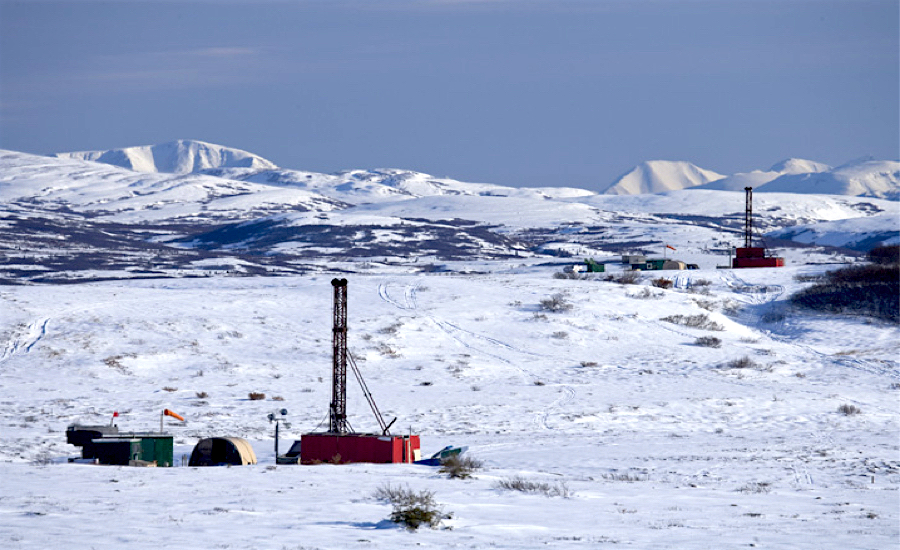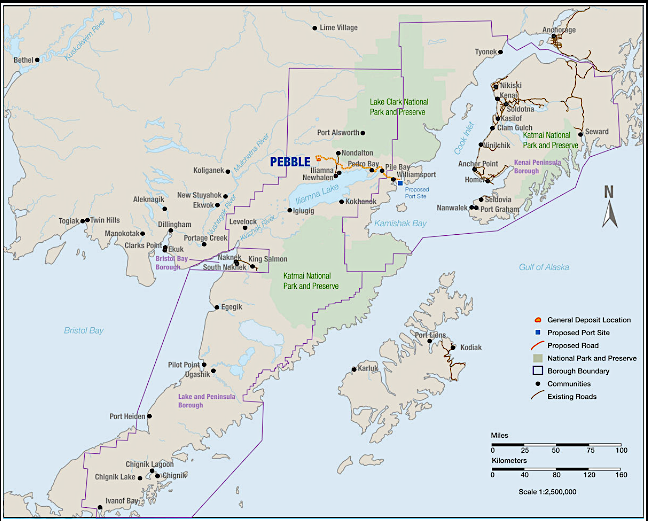EPA, Northern Dynasty settle dispute over Pebble mine

The US Environmental Protection Agency (EPA) and Canada’s Northern Dynasty Minerals (TSX:NDM) put an end Friday to a long-dragged dispute over the federal agency’s decision to block construction of the firm’s vast copper-gold-silver project in Alaska.
The settlement paves the way for an eventual federal permitting decision that could allow Northern Dynasty’s subsidiary — Pebble Limited Partnership — to move forward with the proposed Pebble Mine near Bristol Bay in southwest Alaska.
“Not only are we no longer facing extraordinary development restrictions at Pebble, we will also be assured a fair and predictable permitting review” — President and CEO Ron Thiessen.
“The Pebble Partnership will advance a progressive mine plan, including mitigation, to be assessed by objective, expert regulators at the US Army Corps of Engineers and a raft of other federal and state agencies — including EPA”, the company’s President and CEO Ron Thiessen said in the statement.
“Not only are we no longer facing extraordinary development restrictions at Pebble, we will also be assured a fair and predictable permitting review of our proposed development plan,” Thiessen noted.
Investors reacted positively to the news with the company’s shares spiking almost 8% to Cdn$3.26 in Toronto at 9:39 am local time. The miner’s stock price has been doing quite well ever since Donald Trump’s election victory. After dropping to as low as 25 cents a share at one point last year, the price skyrocketed after the November election, climbing 25% overnight and reaching as high as $3.18 earlier this year, a mark surpassed today after the news.
The agreement comes only a month after Alaska’s Department of Natural Resources (DNR) approved granted the Vancouver-based miner a long-awaited land-use permit, which allows it to to conduct reclamation and monitoring activities at hundreds of boreholes for the next 12 months.
The Pebble Partnership sued EPA in 2014 over the agency’s decision to block the mine on environmental and tribal sovereignty grounds before the company had submitted its permit applications.
Such ruling triggered a legal dispute between the environmental watchdog and Pebble Limited, as well as congressional probes into the validity of the EPA’s action.
One of the company’s main claims was that the agency manipulated scientific results and that some of its staff should have been found to be in conflict of interest.

Pebble project location. (Courtesy of Northern Dynasty.)
But opposition to the controversial project began earlier than that, in the mid-2000s. A 2006-poll by the Cromer Group revealed that 53% of Alaskans oppose it; a second poll ran by Hellenthal Associates that same year found that 71% were against it, and a third poll presented in 2011 stated that 85% of commercial fishermen also reject the project.
Environmentalists, Native American groups, local businesses, a coalition of fishing operators and even the EPA itself have repeatedly expressed concerns about the “irreversible negative impacts” of the mine in one of the planet’s greatest wild salmon fisheries, and the risk it would represent in their view to 14,000 jobs and the $252 million-a-year the local fishing industry generates.
EPA ‘s current administrator Scott Pruitt said the announced deal with the the mining company “will not guarantee or prejudge a particular outcome, but will provide Pebble a fair process for their permit application.”
“We understand how much the community cares about this issue, with passionate advocates on all sides,” Pruitt said in a statement. “We are committed to listening to all voices as this process unfolds.”
The Pebble deposit is one of the greatest stores of mineral wealth ever discovered, according to Northern Dynasty. The current resource estimate includes 6.44 billion tonnes in the measured and indicated categories containing 57 billion pounds of copper, 70 million ounces of gold, 3.4 billion pounds of molybdenum and 344 million of silver.
{{ commodity.name }}
{{ post.title }}
{{ post.date }}




4 Comments
Jim sathome
This deposit will get mined. It’s just a question of when, and /or if the science of the day can reasonably guarantee few negative environmental impacts. I’m not certain they can do it with today’s technology, but some day it will be there.
Ronnie z
How long til fed permit?
Andrew Bamber
6.44B tonnes with 57 B lb contained copper, that’s a grade of approx 0.4%Cu… that could get mined ‘properly’. Presumably there’s a billion tonne nugget within that 6B tonnes at higher grade than 0.4% which would underpin a quite high quality operation using current best available technology.
Robin Samways
As someone who has a degree in environmental resource management and a geology minor, I think folks investing in this project should be warned how long it will be before this mine ever begins producing (if at all.) The Army Corps of Engineers will not have the EIA done for 3-4 yrs. It actually does take that long to work all that out. If/when they do, then the permitting recently fought for will take upwards of 1-2 yrs more. Now, if Trump is still in power at that point, you may get everything passed, but… Alaskan legislature is comprised predominantly of folks voted in by Alaskans against the project, and they will have the final say (aside from a sitting president in extreme times) regardless of the permits. So, even if everything goes right… you still have to change people’s minds. That is almost assuredly not going to happen. One need only engage a few Alaskans and they will tell you it won’t happen.
Temper your enthusiams, people. This mine has been in the works for nearly 30 yrs. It will likely be another decade, if ever. If you plan to invest, at least be informed and understand this road will be very long and very bumpy.